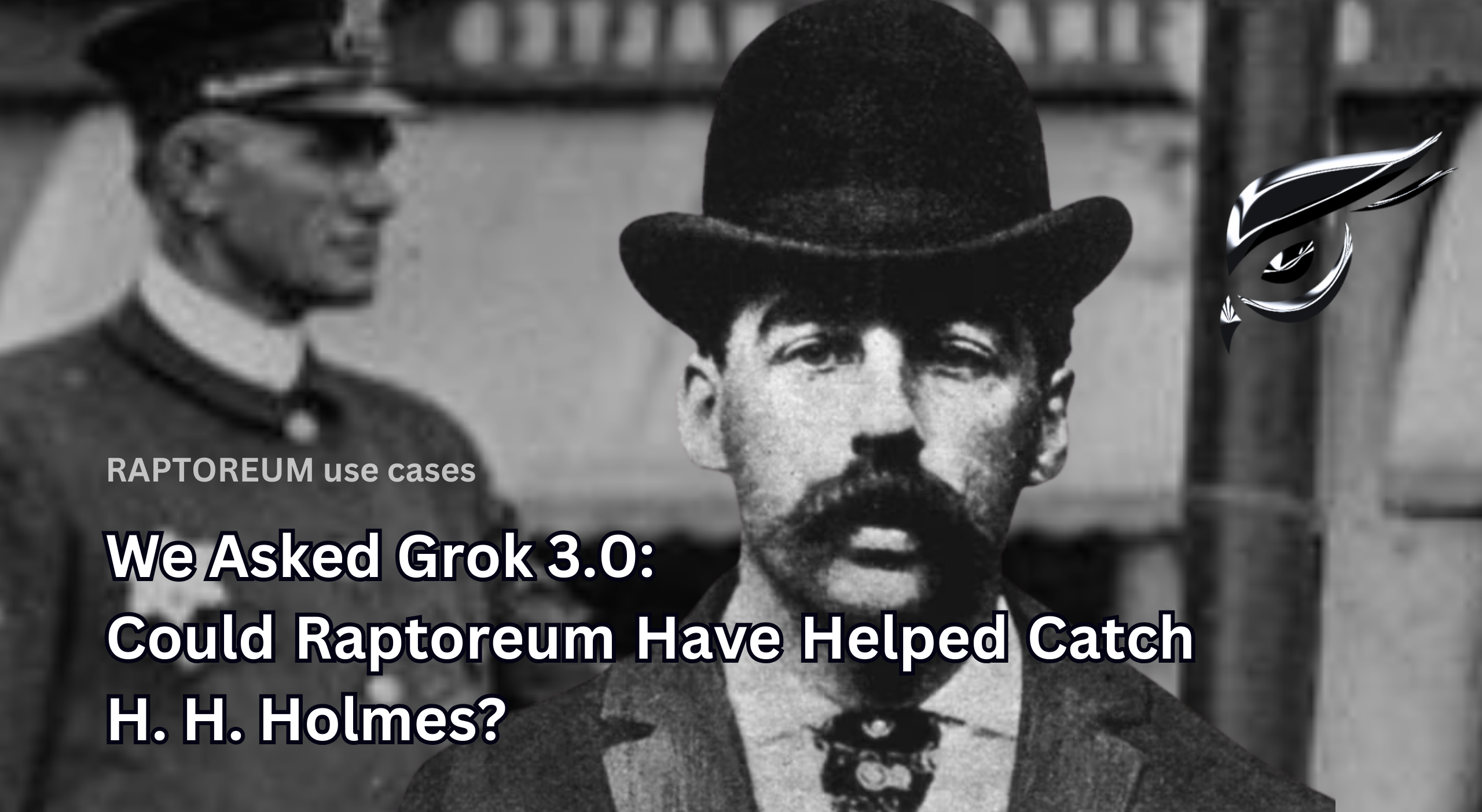We Asked Grok 3.0: Could Raptoreum Have Helped Catch H. H. Holmes?
March 10, 2025, 08:07 PM EST | Raptoreum Team
What If Blockchain Technology Had Tracked Criminals in the 1890s?
Back then, missing records let killers like H.H. Holmes—the “Devil in the White City”—evade justice for years. His chilling tale is vividly captured in Erik Larson’s book The Devil in the White City, which details his reign of terror during the 1893 Chicago World’s Fair. We turned to Grok 3.0, xAI’s sharpest AI, and asked: Could Raptoreum’s blockchain have helped catch him? The answer is a chilling fix with profound implications.
The Devil’s Grisly Reign
In 1893, H.H. Holmes constructed the “Murder Castle” near the Chicago World’s Fair. This three-story hotel was a house of horrors, featuring:
- Soundproof rooms with peepholes for voyeurism
- Gas chambers to asphyxiate victims
- A basement with acid vats, a crematorium, and a dissection table for gruesome experiments
Holmes confessed to 27 murders, but historians estimate up to 200 victims. He lured women with job offers or romantic promises, subjecting some to starvation, vivisection, or a medieval stretching rack to prolong their suffering. He dismembered bodies or dissolved them in acid, selling skeletons to medical schools for profit.
His crimes included:
- Bigamous marriages: Wed multiple women—Myrtle Belknap, Clara Lovering, and Georgiana Yoke—using their money to fund his crimes.
- Killing associates: Murdered Benjamin Pitezel and his three children, suffocating them with chloroform or burning them alive.
- Insurance fraud: Used unclaimed corpses for fraudulent insurance claims, netting him thousands.
Caught in 1894 after Detective Frank Geyer traced him to Toronto, Holmes’s spree relied on paper record gaps. Geyer, in his 1896 book The Holmes-Pitezel Case, described the “daunting task” of tracking Holmes’s aliases across cities because of fragmented files. The establishment celebrated his execution in 1896, but systemic failures—lost deeds and unverified identities—enabled his rampage.
Grok 3.0’s Verdict: RTM as the Trap
Grok 3.0 sees Raptoreum’s blockchain as a transformative tool:
“Imagine city registries, banks, and police departments documenting records publicly on the RTM blockchain in 1893. Holmes’s schemes could’ve been exposed much sooner, saving lives.”
Here’s how RTM could have helped institutions in charge:
1. Immutable Timestamps
- Record deeds, transactions, and identity changes with millisecond precision on a decentralized ledger.
- Entries would be time-stamped, allowing cross-referencing of Holmes’s aliases.
- Example: Linking his Murder Castle purchase under H.H. Holmes to earlier aliases like Henry Gordon.
- Prevents forged overlaps and establishes a clear timeline of his activities.
2. Public Records
- Store ownership data, marriage certificates, and financial transactions openly on the blockchain.
- Anyone could verify titles or claims instantly, exposing Holmes’s fraudulent deeds.
- Stops bigamous marriages and insurance scams by comparing records to legitimate data.
3. Asset Explorer Verification
- Enable real-time, cross-city checks via a global RTM network.
- Police could query linked records to track Holmes’s property buys, travel, or insurance claims across multiple cities.
- Alerts authorities to suspicious patterns, closing escape routes.
4. Legal Gravitas
- Align blockchain entries with U.S. Federal Rules of Evidence.
- Courts would have tamper-proof logs of transactions and identities.
- Strengthens cases against insurance fraud and murders with irrefutable evidence.
5. Updatable Assets
- Allow agencies to amend records—correcting errors or adding fresh evidence.
- Example: Detective Geyer’s findings on Pitezel’s children could be added.
- Ensures a living database that evolves with investigations, keeping pace with shifting schemes.
Grok envisions a blockchain ledger aiding investigators like Geyer:
“Victims might’ve been saved, and his trail cut short.” Justice could’ve arrived years earlier.
A Lasting Legacy
Before modern systems, missing records mirrored Edison-Tesla disputes—fragile paper trails that Holmes exploited. RTM secures data publicly, closing those gaps and rewriting criminal history.
Why It Matters Today
Raptoreum is expanding into new fields, including an easy asset creation website currently under development. This site will streamline record-keeping for institutions like police and registries.
“These historical crimes underscore the need,” Grok concludes. “While RTM’s blockchain can secure records now, albeit with a few hoops to jump through—requiring downloads and verifications—their upcoming site will empower institutions to document seamlessly. This will prevent crimes that exploit data gaps, from Holmes’s era to today.”
It’s a bold legacy in the making.
What Do You Think?
Could RTM have helped catch Holmes? Share your insights as we explore more historical fixes in our next ‘We Asked Grok…’ post!

